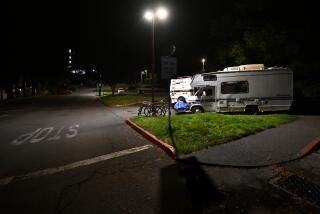Homeless Kids in Class Act : Unusual School Searches for Children Who Might Be Left Out
In many ways it resembled the first day of the school year everywhere: Parents bade farewell to children who were teeming with nervous energy and happy anticipation.
But the difference became obvious when the YWCA van pulled up to one of the first “bus stops,” a motel called the Village Inn in Anaheim. A child in the van recognized a tall sign that proclaimed “Rates by the Week.”
“We were there just a few days ago,” said 8-year-old Chelsey, who helped the bus driver with directions on this his first day on the job.
Chelsey’s father, Wayne Roberts, a taxicab driver, said that since his wife recently gave him custody of their two children, he has been unable to establish a permanent address necessary to enroll them in a traditional school. They are living temporarily at his parents’ home.
So on Monday Chelsey and her brother Michael were among 17 essentially homeless children who boarded the van. Others waited at several motels in Orange and Anaheim. One family of Mexican immigrants who live in a Dodge van had three children ready to be picked up at Pioneer Park in Garden Grove.
Everyone on the van was bound for the Project Hope School, a half day of classes in reading, writing and arithmetic provided four days a week--in addition to a Friday of arts, crafts and field trips--at the YWCA in Orange. The school, functioning since February of 1991, is intended to allow children from displaced and financially struggling families to obtain the skills they will need to someday meld back into the educational mainstream.
The project is a cooperative effort. The Orange County Department of Education provides a teacher and an instructional aide. The YWCA provides a free breakfast and lunch, volunteer tutors and the van. And the First Presbyterian Church of Orange provides classrooms in its building next door to the Y.
Finding students for Hope School is a challenge, school officials say, since most of last year’s students have moved and there are always new homeless children entering the area. Only seven of the 17 children who arrived at Hope School on Monday were returning from last year.
This year school started two weeks late because of last-minute personnel changes, one of which was caused when the program’s teacher underwent emergency heart bypass surgery.
Leslie Adcock, who was brought in as the substitute teacher, said that since Sept. 8, she and an aide have been hunting for students by placing flyers in local motels, self-service laundries and social service offices and touring local parks for families who might be camping out.
In addition to the children who have enrolled at the Hope School, Adcock said, 60 more homeless students are being taught via a mobile van and independent study courses.
For the last two weeks, Adcock said she and her aide have been meeting with the Project Hope students where they live to give them a head start on their schoolwork.
Parents who met the van Monday said they were grateful for the school and the special attention that their children get from the teachers and volunteers.
“I thought it was so wonderful when I got the leaflet. It was like a miracle,” said Patricia Arinwine, who recently moved with her two sons from Los Angeles to the Village Inn motel in Anaheim.
Kyle and Sean Swift, 5 and 6 respectively, were so anxious for school that while they waited for the school van at the Broadway Motel, they sprawled on the hood of the family Chevrolet to write in their workbooks.
“They are dying to get back to school,” said their mother, Sherry Swift.
When they got to school, the children wolfed down a breakfast of pancakes and bacon and headed to class. The students ranged from 5 to 13, which didn’t always match their scholastic age because of their checkered schooling.
They were divided into three small groups, with kindergarten and first-graders in one room, second- through fifth-graders in another and sixth- through eighth-graders in the last.
Soon, with the help of five volunteers, a lot of one-on-one teaching was going on.
Hank Sato, a retired teacher, was teaching “rounding off” to Hector Uriarte, a 13-year-old living in parks with his parents, who speak no English.
Sato opened his wallet and asked, “How much money do you think I have?”
“You want me to guess?” Hector said.
Sato said, yes, that was part of the concept. Rounding a number is an inexact business he explained, bringing it to the nearest hundred or thousand, for example.
“But do you really need to know this?” Hector asked.
“What if you want to buy a house or take a vacation? You will have to estimate how much to save,” Sato said, apparently convincing Hector that learning rounding off might indeed come in handy.
Adcock said Hector was an example of why children at Hope School must be taught individually.
“He is at the eighth grade in math but studies from a third-grade phonics book,” she said, because he has been in the United States only a few years.
This year Hector brought with him his 5-year-old sister Heidi, who was wide-eyed with excitement and smiling when she couldn’t quite understand the English being spoken. Her hair was cropped short, which, an instructor said, was the Mexican culture’s way of encouraging thick tresses.
Judy Grasso, a retired Nebraska elementary school teacher, said it was significant that nobody was making fun of Heidi’s hairdo.
“In a different school, heaven help you. But here nobody pays attention,” Grasso said.
Tutors and teachers agreed that the children at Hope School are especially tolerant and helpful to one another. In some ways, they said, Hope School is like an old-fashioned, one-room schoolhouse where the older children pass on what they learn to the younger.
Adcock said Hope School also teaches children with little previous classroom experience the discipline they will need to succeed in a regular school environment.
“It builds self-esteem and a sense of responsibility,” she said.
Adcock stressed that her goal is to get the children into a more complete school program. She admits that because of the time crunch and the need to stress the three Rs, the Hope School students get shortchanged on social studies, science and other curricula.
As 9-year-old Cassie Pruitt walked to lunch with her new friend Chelsey Roberts, she said to her friend, “I like school. Do you?” Chelsey nodded in the affirmative.
“I like to learn,” Cassie continued later as she dug into a plate of spaghetti with meat sauce. Lunch is an important bonus, Cassie said, confiding that she would have difficulty bringing a sack lunch to school. “At home we don’t have any money.”
Some parents said that at regular schools their children are sometimes taunted by more privileged students who call them “motel kids.” Kaylee Batoosingh said, by contrast, Hope School, is a positive experience for her children Laura, 8, and Matthew, 6.
“They come home from school floating on air. They think they are the most special kids in the world and that’s important,” she said.
More to Read
Start your day right
Sign up for Essential California for news, features and recommendations from the L.A. Times and beyond in your inbox six days a week.
You may occasionally receive promotional content from the Los Angeles Times.






